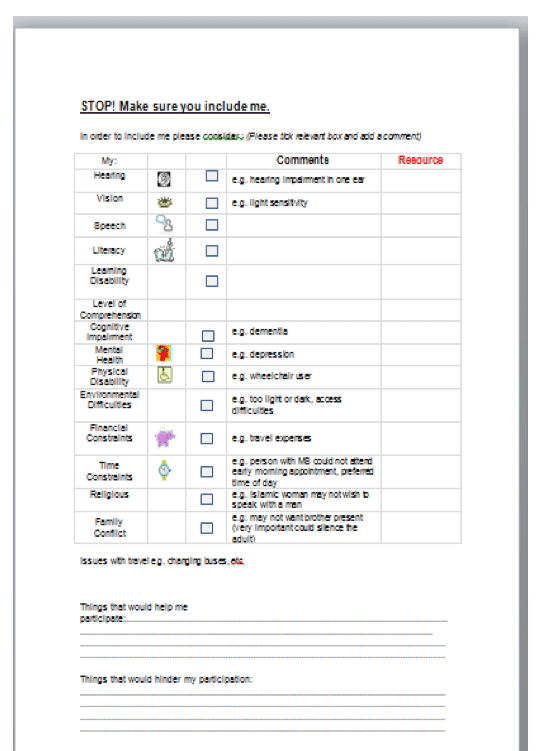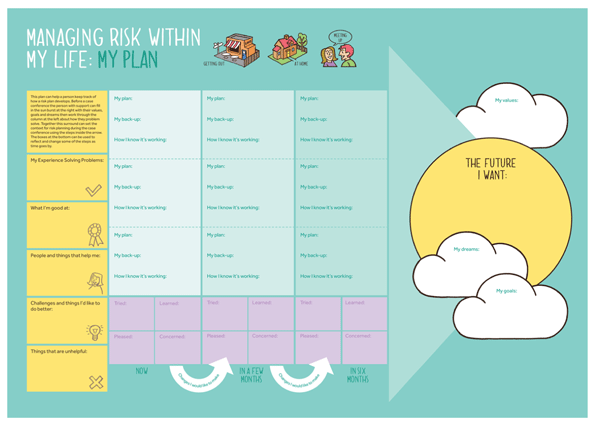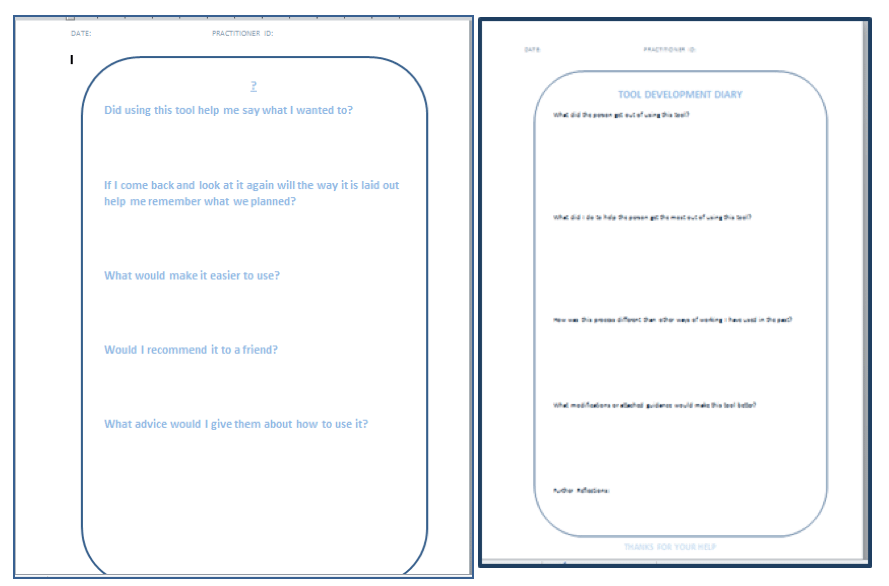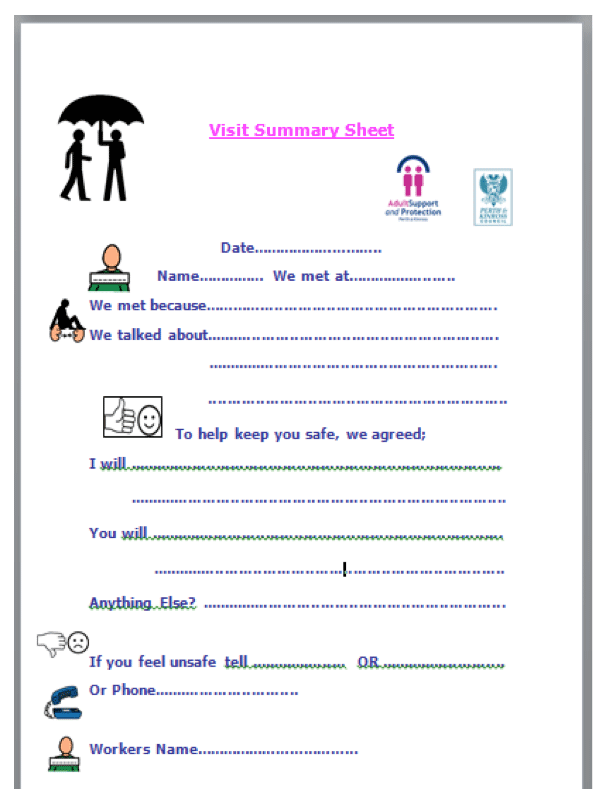A Project To Support More Effective Involvement Of Service Users in Adult Support and Protection Activity
A Project To Support More Effective Involvement Of Service Users in Adult Support and Protection Activity
Chapter 3: The work of the teams
Introduction
3.1 This chapter gives an overview of each team's work. It details how they set up their team and why they chose the ASP issue they wished to work on. Their planning process, challenges faced and resulting tool or approach are reported. The summaries for each team have been developed from notes taken after meetings with the researchers and during the second workshop day as they discussed their tool and their journey.
City of Dundee Team: Importance of Participation
Team members
Brian Rapley, advocacy worker for older people, Dundee Independent Advocacy
Bobby Brown, an older person with experience of the ASP process
Fiona Gaffney, Care Manager
Maureen Conway, Care Manager
Rose Sinclair, Senior Officer, ASP, Dundee City Council
Team working
3.2 Rose approached the care management team and the advocacy project with the idea of focussing on older people and their experiences of ASP work. A social worker from the First Contact Team approached a service user who had recently experienced adult support and protection work and Bobby agreed to be involved. Bobby does not read or write, has learning disabilities and was often accompanied to meetings by his close friend. As a group they brainstormed where they felt they did not do so well in ASP work, from the perspective of frontline workers and from the perspective of an advocacy worker. One meeting was given over to Bobby so they could listen to his story and learn from his experience. This allowed Bobby to talk through some of his feelings and emotions about the whole ASP process. This was described as a privilege by the workers because they appreciated this was a rare opportunity to meet service users outside of their own one-to-one work. This allowed them to see the work and its impact on him through his own words. It also helped to further free them up to think critically about their work and ASP procedures. They felt at times they were struggling with direction but part of the journey was realising there were various points in the ASP process that might be targeted for improvement but that their starting point needed to be something discrete and achievable.
Chosen issue: Improving the service user's participation in ASP
3.3 Bobby highlighted communication as a problem for him to take part in proceedings and it was one of the barriers identified by the group as a whole. Participation was a theme that underpinned all their ideas and Bobby's story underlined the importance of practitioners knowing, and then responding to the fact that he does not read or write. The team felt this could be a factor particularly in ASP inquiries and investigations, where the practitioner is under pressure to gather information and make a judgement about risk of harm. These issues are even more likely to occur if the person is not known to social work. However, even when knowledge about how to effectively include people was built up by individual workers, it did not seem to be fully recorded or easily found by others who worked with the person later in the ASP process.
3.4 Therefore, the Dundee team wanted to raise awareness that identifying participation needs and addressing them, as far as possible, was an important part of investigation work. However, the team realised many of the barriers to participation were not about specialist technology but about the practitioner modifying their approach as guided by the needs of the service user, for example, where they should sit in relation to the person they were speaking to so they could see and hear them better, and finding out who helped the service user to speak out and who had the opposite effect. The team then started to think how they might devise a tool that might lead practitioners to support people to engage with the process as fully as possible and could be accessible to others involved in ASP work.
The tool: 'STOP! Make Sure You Include Me'
3.5 The team developed a one page participation tool 'STOP! Make Sure You Include Me' which was designed to:
a) Prompt the practitioner to consider the wide range of factors they had identified
b) Identify and record ways in which the best participation could be achieved
c) Lead to discussion with the person about referral on to services that might address participation barriers, for example, hearing and sight impairment
d) Be easy to use and accessible across the agency.
A full sized copy on the tool has been placed in Appendix 2
Figure 1: Dundee City Tool
Piloting and dissemination
3.6 The team were aware of the danger that their tool might be viewed as another piece of paperwork that had to be filled in. They hope that it is easy to use and that part of the next stage will be about identifying resources to improve participation of service users in all aspects of ASP, not just recording the issues on the form. They plan to trial it with care managers after gaining approval from senior management. They are also considering how Bobby's and others' real stories might help to get key messages across to their colleagues. There is also the possibility of a resources 'pack' of all different types of local support that might be grouped together for service users to access to overcome barriers to participation from hearing and sight services to computer classes. This might also reduce social isolation in general. There are also implementation questions that the teams are thinking through: should the service user get a copy? should it be routinely sent along with any referral to advocacy workers and any other agency?
East Ayrshire Team: Piloting existing risk planning tools and integrating them into council IT systems
Team Members
Jenny Bruce, ASP Learning and Development Practitioner
Lee McLaughlin, Team Manager, Self- Directed Support
Senga McCulloch, Manager, Balmoral Road Day Centre
Team working
3.7 Jenny Bruce, Adult Support and Protection Learning and Development Practitioner, approached Lee McLaughlin, Team Manager, Self-Directed Support and Senga McCulloch, manager at a day centre with an open door policy where service users would have scope to contribute to the tool on a flexible basis. Involvement in the project was approved by both the Adult Protection Committee and senior management within East Ayrshire Social Work.
Chosen issue: Working with the Altrum Risk Research Team risk planning tool
3.8 The project took place at a time when a lot of different strands of work such as child and adult protection and domestic violence were being brought together under the banner "Protecting People". This is being done to make it is easier for a member of the public to raise a concern about harm to anyone they come in contact with, but will require better inter-professional working.
3.9 The East Ayrshire team's concern was to both stream line and make more accessible routes of communication and decision-making throughout the ASP process, with a particular concern for tools that young adults would want to engage with that would not be stigmatising. Digital media are increasingly an important part of young adults' lives and it was thought that creating tools which they could access digitally would be worth exploring. They are also increasingly important in how agencies support staff in practice and therefore another aspect of work currently underway in this council is an exploration of digital technology to assist communication between a wide range of service providers and the public.
Approach/tool developed
3.10 The team decided to:
- Pilot the Altrum Risk Research Team risk planning tool that takes a visual life planning approach used within self-directed support processes with younger disabled adults
- Use simple evaluation tools to capture practitioner and service users' experience of using the tool
- Develop a software application based on the tool that would engage younger service users and be compatible with the council's IT systems
Figure 2: Altrum Risk Research Team's Risk Planning Tool
A fuller sized copy is in Appendix 2
3. 11 Issues raised
- Concern that service users may shy away from involvement as they have not wanted to talk about sexual harm in the past
- Concern that one style or way of depicting things can't fit all. Images quickly pick up connotations from past service use which can be unhelpful. A tool that would allow service users to choose the style of illustration they would use would be useful
- Information technology systems and security of information: anything developed as an electronic version of the Altrum Risk Research Team risk tool needs to be secure and able to fit within or interact with existing Local Authority systems and technology
- Whilst the tools were pre-existing, this project highlights how the next stages - getting management and practitioners on board can be time consuming but worth the effort as a number of teams have now agreed to take part. This project also demonstrates how services users are not a homogenous group and not always inclined to be part of an on-going project
Piloting and Dissemination
3.12 A tool to capture evaluation from practitioners and service users was developed and distributed amongst the team. The open door policy at the day centre was used to gather service users' initial reactions to it.
3.13 Social Work Services within the Local Authority agreed to pilot the tool including Mental Health and Criminal Justice team. There is now organisational level agreement to do this but the workers who will do the piloting are still being determined. Once these people are identified, any training needs they may have in order to use the tool will need to be assessed and training delivered.
Figure 3: Tool Evaluation Diary Sheets
Full sized copies are in Appendix 2
3.14 Working towards an interactive IT application highlighted two unique learning points:
1. Utilising staff and student university resources: Beth Cross helped the East Ayrshire team explore partnership with The University of the West of Scotland School of Computing to involve fourth year students in designing a software application for ASP work. This involved students working with East Ayrshire Council representatives from ASP, IT services and the SWIFT (computer records system) support team to try to create a format that could be used securely with existing systems.
2. In-house attempts at creating an electronic version highlighted that IT client recording systems may not have applications that allow the Risk Planning Tool to be lodged there. Features of the hard copy design (large size and use of colour that makes it attractive document to work with services users) do not suit existing computer programmes that are based on word as text. Learning about the IT solutions for these challenges could open up council recording systems to the use of mediums other than standard text.
Perth & Kinross Team: Visit summary sheet
3.16 This summary was written by the team themselves in order to present their work to the ASP lead officer. It is slightly re-ordered to fit with report headings
Team membership
Susan Hynd: Depute manager for Kinnoull Day Opportunities, a community based day service for adults with learning disability
Neil Dunn: Service User, Kinnoull Day Opportunities
Rhona Maxwell: Independent Advocacy Worker
Helen Winter: Learning Disability Social Worker
We also consulted with Speech and language therapist, Karin Taylor
Team working
3.17 The team looked at the objectives of the project and decided to focus their work on developing something which would improve the participation in and experience of the ASP process for service users. We decided to focus on learning disability service users within the ASP process as a high percentage of initial ASP referrals are for people in this group. We looked at the service users' perspective and tried to think about what kind of things may be helpful for them.
3.18 Initially we thought about designing some kind of easy-read version of current ASP literature, however, this proved difficult once we started to develop it. It was important that we gave people, using the leaflet, information that was relevant to them, without making it too broad and giving them too much detail about more specific aspects of the process that may never affect them, and putting them off.
3.19 After discussion with the speech and language therapist, the group changed their mind and decided to pursue developing what we now call our 'visit summary sheet'.
3.20 Neil completed a consultation with service users on the Talking Mats ASP symbols and found that when taken out of context they are often misinterpreted. There is currently a roll out of ASP training throughout Scotland for learning disability service users, and the expectation is that with repetition and consistency in the use of these symbols people will become more familiar with them. The more general symbols are currently used in a wide variety of literature on the topic, both nationally and locally. As well as the colours used reflecting those of existing local literature on the topic, the visit summary sheet is also written in the recommended format using Verdana font, size 14, with 1.5 line spacing.
Chosen issue: Improving service users' understanding of the ASP processes by leaving them with a written record of any visit
3.21 Our group have designed what we call a 'visit summary sheet' for social workers to use as a simple record of their ASP visit to a learning disability service user. This visit summary sheet is something which does not yet exist locally and there has been a need expressed for this kind of tool. The sheet was produced in consultation with speech and language therapy and has been designed specifically so that it may be used after a visit at any stage in the ASP process (initial visit, investigation visit or final meeting). The sheet serves as a memory prompt as there is space for the worker to fill out relevant information which they feel appropriate to leave with the client. It is not intended to be a full record of information on the work as this will be recorded by the worker in their own set formats and within their database. It is instead something for the benefit of the service users themselves to prompt their memory for answers to the 'who/why/where/what/when' questions that they may have following a visit.
3.22 Tool: Visit summary sheet
Figure 4: Visit Summary Sheet
Full sized copy in Appendix 2
The following advice will be placed on an A5 diary sized card:
"Name": This should be the person's first name only in order to preserve anonymity should the sheet get lost or fall into the wrong hands.
"We met at…": This should be the name of a place (e.g. home, Day Centre, Dobbies), in order to keep things simple and anonymous.
"We met because…": This section should record the nature of the concern that has been reported
"We talked about…" This should be a brief summary of important points of the discussion that took place during this visit.
To help try to keep you safe, we agreed;
"I will…" (worker): This is a description of measures has either already in place or to be put in place. This can be a wide range of things including putting additional support in place, increased supervision (e.g. in the workplace), speaking to others for more information, involving other services (e.g. police, health), arranging a case conference, making a referral to the independent advocacy service, holding more frequent review meetings etc.
"You will…" (service user):This should be a description of things the person themselves can agree to do, such as tell others if they are concerned about anything, or take action to avoid being in a vulnerable situation.
"Anything else?": This section is for anything else that may have been brought up during the discussion which may not be directly relevant to ASP but is important to the person. For example the person may ask when they are next on respite or when the summer disco is. The worker can still record this and agree to pass this information or question on to someone.
"If you feel unsafe tell": Through discussion the worker will agree one or two people who the service user trusts to speak to and who is readily available. The person(s) named should have frequent and direct contact with the client e.g. their mum/key worker.
"or Phone…": This should be the duty social work and/or out of hours phone number.
"Worker name": This should be the name of the lead worker who visited them today. If the person is allocated to another worker this information will be stored on the local authority database and be established by the person phoning the relevant number and giving their own details.
Piloting and dissemination
3.23 Our intention is for this sheet to be adopted for use by learning disability social workers within Perth & Kinross Council, however, we believe it can be easily adapted for use with other groups subject to ASP procedures. For service users with less capacity or difficulty understanding written words, workers may consult with speech and language therapists and/or have access to other symbols which may be used to fill in the blank spaces.
3.24 Permission has been sought and given to pilot this tool within the learning disability team. We are aiming to use it with hopefully 10 service users and seek their views of how useful or not they found the sheet. The evaluation tool developed for the East Ayrshire team will be used for this purpose. We will then reflect on its overall impact and redesign it as necessary. There are plans to present our work at a practitioner forum and then see how more widely the tool might be used.
North Lanarkshire and The Advocacy Project
Team members
Kaye MacGregor, ASP Coordinator, North Lanarkshire
Michelle Howorth, The Advocacy Project
3.25 Late into the planning stage of this research North Lanarkshire approached Beth Cross with a general interest in Altrum Risk Research Team Work. Although technically too late to be included in the proposal it was felt that continuing a dialogue with North Lanarkshire and the advocacy provider for them would be in the spirit of the project. Michelle contacted the research team via the IRISS blog as she had recently helped to undertake an ASP evaluation for North Lanarkshire and other councils. Whilst this information was yet to be approved for public sharing, it had motivated her to consider how to take the findings into changing practice. The Advocacy Project had a particular interest in the diary tool developed within the Altrum Project which provides service users with a record of meetings alongside an illustration that helps them place the meeting within the overall process of a risk investigation. The tool to evaluate how well the Altrum tool worked in practice, which had been devised with East Ayrshire, was shared with them and they gave initial feedback and made a commitment to begin to look for opportunities to pilot and evaluate the Altrum Meeting Diary Tool. At the time of writing this report these opportunities have not yet arisen.
3.26 However, the North Lanarkshire Team's presence at the second national day brought further perspectives to discussions about all the various tools developed and particular insight into forum theatre approaches that they had successfully used to explore relations between person at risk, carer and services at a local authority carers and service users day. It also reinvigorated their desire to test out the tools in their own area and hopefully draw on the other teams' experiences.
Summary
3.27 The teams' work demonstrates how effective small teams, made up of different perspectives, can be in short-term project work. Together the proposed tools have the potential to improve service users' understanding of ASP (what and why things are happening), to have their views heard and to be able to participate more meaningfully. The common underpinning aim is to aid communication as a two way process between service user and practitioner. This underlines that the tools are not an end in themselves. Instead, they should be seen in the context of why they were developed and how they might promote a better shared understanding between practitioners and service users, which then might ripple out into other parts of the ASP process.
Contact
Email: Stephanie Robin
There is a problem
Thanks for your feedback



